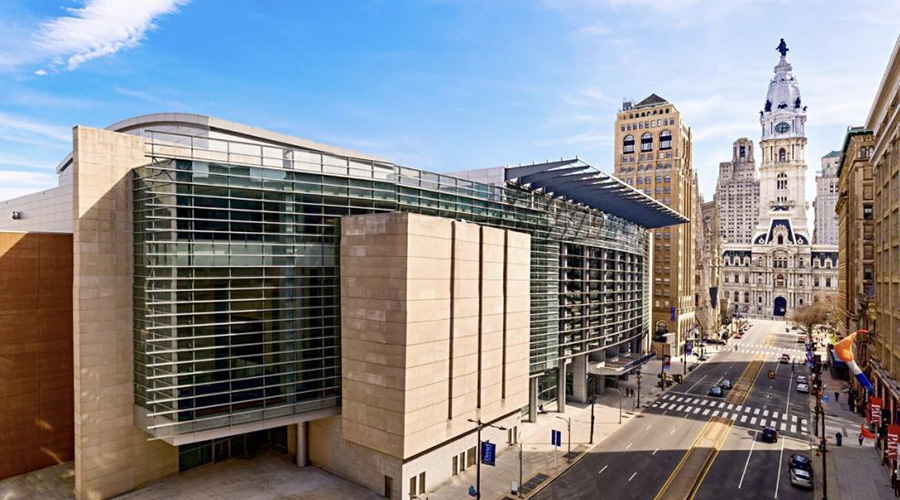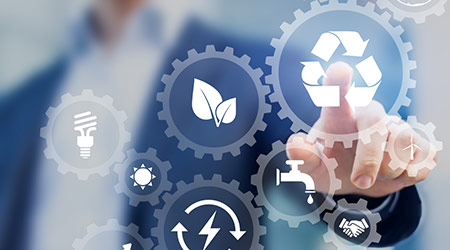Pennsylvania Convention Center Sets a National Example with Smart, Sustainable Upgrades – Facilitiesnet

Report on the Pennsylvania Convention Center Modernization and Alignment with Sustainable Development Goals

Introduction
The Pennsylvania Convention Center (PCC), a critical economic engine for the City of Philadelphia, has completed a $15 million infrastructure modernization project. This initiative, led in partnership with Siemens, was designed to reduce environmental impact, enhance operational resilience, and improve visitor health and safety. The project’s outcomes demonstrate a significant commitment to and advancement of several United Nations Sustainable Development Goals (SDGs).
Project Contributions to Sustainable Development Goals (SDGs)
SDG 3: Good Health and Well-being
The project placed a high priority on creating a safe and healthy indoor environment for over one million annual visitors and staff. Key contributions include:
- Enhanced Air Quality: State-of-the-art air purification and ventilation systems were deployed, including needlepoint bipolar ionization technology and upgrades to Variable Air Volume (VAV) HVAC systems.
- Health and Safety Accreditation: The Center achieved the Global Biorisk Advisory Council (GBAC) STAR
 Facility Accreditation, recognized as the gold standard for outbreak prevention, response, and recovery.
Facility Accreditation, recognized as the gold standard for outbreak prevention, response, and recovery. - Real-time Monitoring: Digital solutions enable continuous, real-time monitoring of air quality and temperature in every meeting room, concourse, and exhibit hall, ensuring optimal conditions.
SDG 7: Affordable and Clean Energy
A core objective was the reduction of energy consumption and the transition to cleaner energy sources. The project achieved this through:
- Energy Efficiency Upgrades:
- Installation of energy-efficient LED lighting throughout the 2 million square foot facility, saving 4.5 million kWh annually.
- Attachment of Variable Frequency Drives (VFDs) to motors, saving 530,000 kWh of power per year.
- Integration of the facility’s two central heating and cooling plants, saving 1.3 million kWh annually by allowing one plant to serve the entire building during periods of low occupancy.
- Clean Energy Transition: The Center migrated a significant portion of its power supply, with 50% now derived from wind energy.
- Smart Grid Interaction: Implementation of an automated demand response program allows the Center to curtail energy use during peak grid demand in exchange for lower rates, contributing to grid stability.
SDG 9: Industry, Innovation, and Infrastructure
The modernization represents a significant upgrade to a critical piece of regional infrastructure, leveraging cutting-edge technology to build resilience and efficiency.
- Smart Building Technology: Siemens’ Desigo CC building automation system, along with meters and sensors, provides a foundation for data analysis, operational optimization, and predictive maintenance.
- Resilient Infrastructure: The custom-engineered integration of the East and West heating and cooling plants created critical redundancy, ensuring continuous operation and enhancing facility resilience against equipment failure.
- Innovative Financing: An Energy Services Conservation (ESCO) partnership and a $15 million lease solution from Siemens Financial Services enabled the project to be funded through guaranteed future energy savings, removing the need for large upfront capital expenditure.
SDG 11: Sustainable Cities and Communities
The project directly contributes to making Philadelphia a more sustainable city by reducing the environmental footprint of one of its largest public venues.
- Reduced Urban Emissions: The comprehensive energy efficiency measures have reduced the Center’s baseline energy consumption by over 18%, directly lowering the city’s carbon footprint.
- Sustainable Building Certification: The facility achieved LEED Gold certification from the U.S. Green Building Council (USGBC), an internationally recognized standard for sustainable design, construction, and operation.
- Traffic and Emissions Mitigation: The establishment of a marshaling yard for convention-related truck traffic reduces vehicle idling and excessive travel, mitigating local air pollution and traffic congestion.
SDG 12: Responsible Consumption and Production
The Center has implemented operational patterns that promote resource conservation and sustainable practices.
- Water Conservation: The strategic plan included the deployment of technologies designed to lower water consumption.
- Waste Reduction: Initiatives include expanded recycling programs, particularly within food and beverage services.
- Green Procurement: The Center has adopted green procurement practices, prioritizing vendors committed to sustainable goods and services.
SDG 13: Climate Action
The decarbonization efforts undertaken by the Center are a direct response to the need for climate action.
- CO2 Emissions Reduction: The combination of energy efficiency measures, smart controls, and the shift to wind power has resulted in a significant reduction of CO2 emissions.
- Data-Driven Climate Strategy: The use of Siemens’ monitoring and control solutions allows for precise tracking and modeling of energy use, generating sustainability reports that inform future climate action strategies.
SDG 17: Partnerships for the Goals
The project’s success was built on a multi-stakeholder collaboration, demonstrating the effectiveness of partnerships in achieving sustainability objectives.
- Public-Private Partnership: The project exemplifies a successful collaboration between the Pennsylvania Convention Center Authority (a quasi-governmental body) and a private sector technology partner, Siemens.
- Financial Collaboration: The partnership extended to include Siemens Financial Services, which provided the innovative financing model essential for the project’s implementation.
Conclusion
The Pennsylvania Convention Center’s modernization project serves as a blueprint for how large-scale public venues can achieve substantial improvements in sustainability, resilience, and operational efficiency. By strategically aligning its infrastructure upgrades with the Sustainable Development Goals, the Center has not only reduced its environmental impact by over 18% but has also enhanced its economic value and commitment to public health, setting a new industry standard for sustainable facility management.
Analysis of Sustainable Development Goals in the Article
1. Which SDGs are addressed or connected to the issues highlighted in the article?
-
SDG 6: Clean Water and Sanitation
- The article mentions that the modernization plan included “technologies that lower water use” and that “water conservation” was a key initiative. This directly connects to ensuring the availability and sustainable management of water.
-
SDG 7: Affordable and Clean Energy
- The project’s core focus is on energy. It mentions efforts to “cut energy use,” implement “energy efficient LED lighting,” and “migrate to clean energy sources,” with the article stating that “50 percent of the Center’s power supply is now derived from wind energy.” This aligns with increasing the share of renewable energy and improving energy efficiency.
-
SDG 8: Decent Work and Economic Growth
- The article establishes the Convention Center as a “key economic driver for Philadelphia,” which “helps drive $600 million worth of meeting and convention activity.” The modernization project is an investment to sustain and enhance this economic engine, promoting sustainable tourism and economic productivity through technological upgrades.
-
SDG 9: Industry, Innovation, and Infrastructure
- The entire case study is about a “$15 million modernization” of a major piece of regional infrastructure. The project focuses on upgrading the facility to be more sustainable and resilient, using “state-of-the-art” technology and “smart infrastructure investments,” which is the essence of this goal.
-
SDG 11: Sustainable Cities and Communities
- The Convention Center is a central feature of Philadelphia, a “UNESCO World Heritage City.” The project’s goals of reducing “CO2 emissions,” improving “air quality,” and obtaining “LEED Gold certification” contribute to making the urban environment more sustainable and reducing its environmental impact.
-
SDG 12: Responsible Consumption and Production
- The article highlights several initiatives that align with this goal, including “water conservation,” “expanded recycling,” “active energy management,” and “green procurement practices.” These actions demonstrate a commitment to the sustainable management and efficient use of natural resources and waste reduction.
-
SDG 13: Climate Action
- A primary driver for the project was the Center’s “commitment to sustainability and related CO2 emissions reductions” and its “decarbonization initiatives.” The article details how energy efficiency measures and the use of renewable energy directly contribute to climate action by reducing greenhouse gas emissions.
2. What specific targets under those SDGs can be identified based on the article’s content?
-
Target 6.4: By 2030, substantially increase water-use efficiency across all sectors.
- The article points to this target through its mention of “water conservation” initiatives and the deployment of “technologies that lower water use” as part of the upgrade.
-
Target 7.2: By 2030, increase substantially the share of renewable energy in the global energy mix.
- This target is directly addressed by the statement that “50 percent of the Center’s power supply is now derived from wind energy.”
-
Target 7.3: By 2030, double the global rate of improvement in energy efficiency.
- The project’s success in reducing “baseline energy consumption by more than 18 percent” and saving millions of kilowatt-hours of power through LED lighting and HVAC upgrades directly supports this target.
-
Target 8.9: By 2030, devise and implement policies to promote sustainable tourism.
- The modernization, which led to LEED Gold and GBAC STAR certifications, is a clear implementation of a policy to make a key tourism asset more sustainable, thereby promoting Philadelphia as a destination for sustainable tourism.
-
Target 9.4: By 2030, upgrade infrastructure and retrofit industries to make them sustainable, with increased resource-use efficiency and greater adoption of clean and environmentally sound technologies.
- The article is a case study of this target in action. The Center’s “$15 million in infrastructure upgrades” to improve energy efficiency, reduce emissions, and conserve water is a direct example of retrofitting infrastructure for sustainability.
-
Target 11.6: By 2030, reduce the adverse per capita environmental impact of cities, including by paying special attention to air quality and municipal and other waste management.
- The focus on “CO2 emissions reductions,” ensuring “the highest possible indoor air quality,” and implementing “expanded recycling” within a major city venue directly contributes to this target.
-
Target 12.5: By 2030, substantially reduce waste generation through prevention, reduction, recycling and reuse.
- This is addressed by the initiative for “expanded recycling within the food and beverage service areas.”
-
Target 12.7: Promote public procurement practices that are sustainable.
- The Center’s adoption of “green procurement practices (prioritizing purchases from vendors who are committed to delivering high sustainability goods and offerings)” is a direct implementation of this target.
3. Are there any indicators mentioned or implied in the article that can be used to measure progress towards the identified targets?
-
For Energy Efficiency (Target 7.3):
- Reduction in baseline energy consumption: “reduced PCC baseline energy consumption by more than 18 percent.”
- Annual power savings from specific actions: “installing LED lighting… helped save 4.5 million kilowatt hours in annual power consumption.”
- Power savings from plant integration: “1.3 million kilowatt hours (kWh) of power is saved each year through interconnection.”
- Energy savings from HVAC upgrades: “saved 200,000 kWh of energy and 1,900 thermal units of natural gas per year.”
-
For Renewable Energy (Target 7.2):
- Share of renewable energy in the energy mix: “50 percent of the Center’s power supply is now derived from wind energy.”
-
For Sustainable Infrastructure and Cities (Targets 9.4 & 11.6):
- Investment in sustainable upgrades: “$15 million in infrastructure upgrades.”
- Adoption of green building standards: Attainment of “LEED Gold certification.”
- Adoption of health and safety standards: Attainment of “Global Biorisk Advisory Council (GBAC) STAR certification.”
-
For Economic Impact (Target 8.9):
- Economic activity generated: The Center “helps drive $600 million worth of meeting and convention activity in Philadelphia.”
-
For Resource Management (Targets 6.4 & 12.2):
- Use of monitoring technology: “meters and sensors (for gathering electricity, gas and water consumption data)” are used to track resource use.
- Operational cost savings from efficiency: “Process improvements… resulted in $686,000 in operational cost savings through 2021.”
4. Summary of Findings
| SDGs | Targets | Indicators |
|---|---|---|
| SDG 6: Clean Water and Sanitation | 6.4: Increase water-use efficiency. | Implementation of “water conservation” initiatives and “technologies that lower water use.” |
| SDG 7: Affordable and Clean Energy |
7.2: Increase the share of renewable energy.
7.3: Improve energy efficiency. |
“50 percent of the Center’s power supply is now derived from wind energy.”
Reduction of baseline energy consumption by “more than 18 percent”; Savings of “4.5 million kilowatt hours” from LED lighting. |
| SDG 8: Decent Work and Economic Growth | 8.9: Promote sustainable tourism. | The Center drives “$600 million worth of meeting and convention activity,” and its sustainability upgrades (LEED Gold) promote it as a sustainable tourism venue. |
| SDG 9: Industry, Innovation, and Infrastructure | 9.4: Upgrade infrastructure to make it sustainable and resilient. | A “$15 million modernization” project to “boost resilience” and sustainability; Integration of two central heating/cooling plants to enhance redundancy. |
| SDG 11: Sustainable Cities and Communities | 11.6: Reduce the environmental impact of cities (air quality, waste). | Attainment of “LEED Gold certification”; Initiatives for “CO2 emissions reductions” and ensuring “highest possible indoor air quality.” |
| SDG 12: Responsible Consumption and Production |
12.5: Substantially reduce waste generation.
12.7: Promote sustainable public procurement. |
“Expanded recycling within the food and beverage service areas.”
Implementation of “green procurement practices.” |
| SDG 13: Climate Action | 13.2: Integrate climate change measures into policies and planning. | The Center’s “decarbonization initiatives” and commitment to “CO2 emissions reductions” as a core part of its modernization plan. |
Source: facilitiesnet.com

What is Your Reaction?
 Like
0
Like
0
 Dislike
0
Dislike
0
 Love
0
Love
0
 Funny
0
Funny
0
 Angry
0
Angry
0
 Sad
0
Sad
0
 Wow
0
Wow
0



























;Resize=805#)



















































